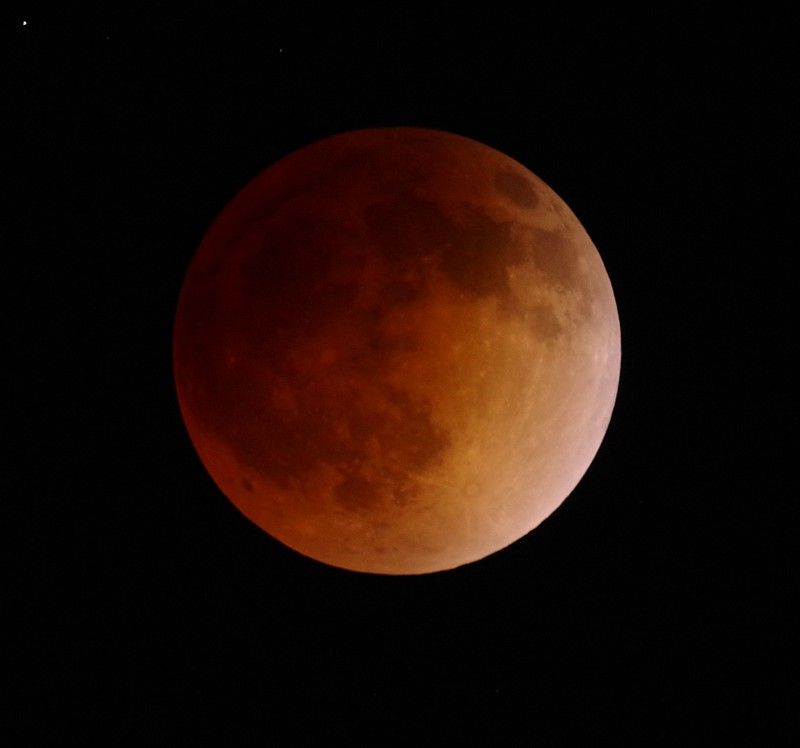
4월 14일 미국 서부 시간으로 밤 10시에 시작하여 11시에는 달이 완전히 없어진다고 합니다.
여기 일기 예보는 구름이 일부 낄 가능성으로 예보가 있습니다. 14일 밤 여기서 달이 보일 가능성은 전날 젇도에 정확히 알 것 같습니다
Night
N
E
S
W
- SSE 4 mph
- Gusts: 7 mph
Partly cloudy; rising temperatures late
만약 여기 날씨가 안 좋을 것으로 전날 예보되면 장비를 가지고 수백 km 날씨가 좋은 곳으로 미리 이동하는 방안도 있습니다.
개기 월식을 어떻게 찍어야 하나요.
그냥 TEC 140에 STL 11000으로 시간 타이밍 주고 찍을까요.
오늘 주문한 카메라는 그날까지 올 가능성이 반반
설사 오더라도 미리 사용안 해 보면 그렇고
스카이메모를 비상용으로 Canon 5ti로 옆에 같이 준비해 놓아야 하겠네요.
물론 가이드겸 Televue 76이나 AT111edt 에 ST 2000xcm을 사용하여 보는 것도 한 방안입니다.
SBIG CCDops 프로그램에 행성모드가 있으니 그 것을 시도해 볼 수 있습니다.
날씨가 좋을 경우 모든 것을 개기월식 찍는데 사용하려 합니다.
그 전날 미리 연습도 해 보고
이것 당분간 달 찍은 연습해야 하겠습니다.
개기월식 촬영 경험 있으신 분들 고견 바랍니다.
P.S.
개기월식 때에도 달이 완전히 어두워지는 것은 아니고 약간 빛이 남는데 대기의 상태에 따라 전주에 화산폭발이 큰 것이 있으면 달이 더 어두워진다고 합닏.
그리고 개기월식 때 밝은 별이 겹쳐 보이면 멋있다고 합니다.
http://www.accuweather.com/en/features/trend/total_lunar_eclipse_will_darke/25463492
무엇을 기대하고 찍어야 하는 것인지. 개기일식 만은 훨씬 못하지만 그래도 기회를 최대한 이용해 보려 합니다.
다크사이트로 가서 달이 가린다음 은하수를 찍는 것도 한 방안일 것 같습니다.
 Diagram showing the appearance of the lunar eclipse of April 15, 2014. Credit: F. Espenak/NASA GSFC
Diagram showing the appearance of the lunar eclipse of April 15, 2014. Credit: F. Espenak/NASA GSFC
Only the shadow knows the moon's color
Although astronomers do not expect to gain new astronomical insights from the eclipse, lunar eclipses vividly reflect the overall state of Earth's atmosphere.
Under normal weather and atmospheric conditions, as the moon slides into the shadow of the Earth, the satellite's normal yellow-white color changes into a dull coppery-red at the height of the eclipse. Since the sun's rays are bent by Earth's atmosphere so that some still reach the moon, the moon is still visible during a total lunar eclipse.
However, if a major volcanic eruption has taken place in the weeks or months prior to a total lunar eclipse, a cloud of ash and dust floating high above the Earth could make the moon appear darker than usual during totality; parts of the moon might even become black and invisible.
Or the moon might wear its normal eclipse cloak of a deep red or a coppery hue or take on still other colors (orange, chocolate-brown or gray). Color possibilities are unpredictable since it is impossible to tell exactly how much light Earth's atmosphere will refract as its shadow creeps across the moon. Cloud cover and other atmospheric conditions may also affect the visibility and coloration of the moon.
In short: We'll all just have to wait for eclipse night and see what actually happens.
Rare pairing off with a bright star
During the eclipse, no doubt many will take note of a conspicuous star situated just to the right and a bit below the moon. This will be Spica, the brightest star in the constellation Virgo and one of the 21 brightest stars in the sky.
During totality, the contrast in color between the eerie red ball of the moon and this bluish star will be striking. A close approach of the eclipsed moon and a particular star is a rather rare event. It last happened with Spica on the night of April 12 and 13, 1968. The next time a bright star will approach as closely to a totally eclipsed moon will be on Feb. 25, 2510, when the star in question will be Regulus in the constellation Leo.
Space.com will provide tips on how to judge the color and brightness of the upcoming eclipse in an April 11 night sky observing guide, and we'll also publish an Eclipse Observers Guide on April 13. So stay tuned!
P.S.
검색하여 보니 블러드 문을 제대로 찍으면 아래 사진처럼 나온답니다.

클라우디 나이트에 이번 개기월식에서 미국 중부 지역에서 찍은 사진이라고 그럽니다.
잘 찍었는에 날씨가 받추어 주어야 저런 사진을 시도할 터인데 다음 개기월식을 기다립니다.

또다른 사진 캘리포니아 남부지역 에서 ES ED80 + Nikon D70
천문촬영하려면 건조한 지역으로 이사가야지 워싱턴주는 기후는 너무 춥지도 않도 덥지도 않으나 흐린날이 많아 천문 촬영은 1년에 60일 정도 가능합니다.
 달을 지나 가는 우주정거장
달을 지나 가는 우주정거장
 행성 촬영 준비
행성 촬영 준비












